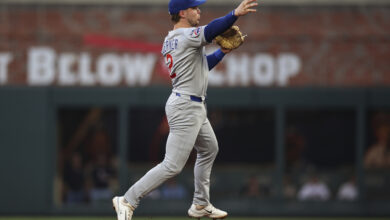
Matt Shaw in Decent Company with Early Demotion
Matt Shaw was demoted to Triple-A Iowa on Tuesday after coming out of the gate cold to start his MLB career, slashing .172/.294/.241 with a 66 wRC+ and one homer. While I’d have been perfectly happy to see him continue working through his struggles at the highest level, there’s plenty of evidence — both statistical and anecdotal — to support a reset in the minors. If forced to guess, I’d say the young slugger suffered from a bad case of indecision at the plate.
There’s so little time to think in the box that hitters can’t afford to wait until the ball is on them to make a swing decision. Rather, they need to step in thinking swing the whole time and only changing if the pitch doesn’t appeal to them. Shaw appeared to be a little too tentative, which could be the foundation for his exceptional walk rate. At the risk of giving him too little credit for an accurate eye, I wonder how many of the pitches he took were more a product of hesitation.
My theory is based on the idea that his strikeout rate was up and his batted-ball numbers down from his time in the minors. That is to be expected to an extent, but seeing his bat speed (9th), expected slugging (5th), hard-hit rate (4th), and average exit velocity (2nd) all in single-digit percentiles tells me he wasn’t getting his A-hack off frequently. Looking under the hood at his plate discipline numbers further clarifies the story.
Shaw’s always had a good eye and maintained a very similar swing rate on pitches outside the zone, but his overall swing rate was down nearly five points from last year (55.1% to 59.7%). That came from being a few ticks down when it came to in-zone swings, an issue exacerbated by the fact that MLB pitchers threw him strikes at a much higher percentage than he saw in the minors.
First-pitch strikes proved to be a particular form of Kryptonite for Shaw, as he saw them at a 57.4% clip after having never seen more than 48.7% in the minors. Facing a bunch of less experienced hurlers who were far more content to get cute seeking chase didn’t adequately prepare Shaw to battle grown-ass men who knew they could beat him in the zone.
Sure enough, his most common ball-strike count was 0-1 (33 plate appearances) and he batted .097 in those situations. Think about how different his stat line might be if he’d ambushed a few more of those early strikes. Now it’s a matter of him building back the confidence to know he can punish pitchers for that mindset. He doesn’t have to look too far for inspiration on how well that can work out.
The man currently leading the Cubs with 1.2 fWAR and a 184 wRC+ as he tracks toward a potential half-billion-dollar contract this offseason didn’t set the world on fire when he first came up. Kyle Tucker was promoted in July of 2018 and finished the season with Houston batting .141/.236/.203 with a 28 wRC+ and no homers over 72 plate appearances. While he was around two years younger than Shaw at the time, he had accumulated over 1,000 more professional plate appearances prior to his debut.
Coincidentally, Tucker again logged 72 PAs in 2019 after a September call-up in his sophomore campaign. He fared much better, posting a .269/.319/.537 slash with four homers and a 121 wRC+ that showed stronger signs of life. He was up for good from 2020 on and has proven to be one of the most complete hitters on the planet, so it doesn’t look like the rough first stint hurt him.
With the Cubs playing in San Diego, perhaps we should talk about Anthony Rizzo. The franchise cornerstone matched Tucker’s early batting average with a .141 mark over his first 49 PAs, but his .281 OBP and a homer elevated his wRC+ to 59 in the short stint. The Cubs acquired Rizzo after that season and gave him plenty of runway in Iowa before calling him up to stay in late June of 2012.
Jed Hoyer offered a few additional examples when speaking to reporters about the demotion ahead of Tuesday’s win against the Padres.
“I mean, we look at (Kyle) Schwarber, (Ian) Happ, Rizzo, Javy (Báez),” Hoyer said, “all those guys have gone back. This is part is part of it, it’s really hard to break into the big leagues and even guys that seem like they just establish themselves need to go back at some point for a reset.
“So I don’t look at this as a negative, it’s part of the process and I’m sure he learned a lot. We faced a lot of really good pitching, it’s been a great learning experience for him and I think he has the kind of head on his shoulders that he’ll take what he learned, go back down to Iowa, think about it, and I think he’ll come back better and more ready to go.”
Schwarber, Báez, and Happ are a little different because all of them came out absolutely banging following their initial promotion. Still, all had holes in their swings that were exposed and they needed time in the minors to recalibrate. We don’t have time here to get into the long-term efficacy of those adjustments, but suffice to say the Cubs ended up getting pretty solid production following their respective returns to Chicago.
Getting a little more aggressive and being confident attacking strikes should put Shaw on a much better trajectory when he gets another shot at big-league pitching.

